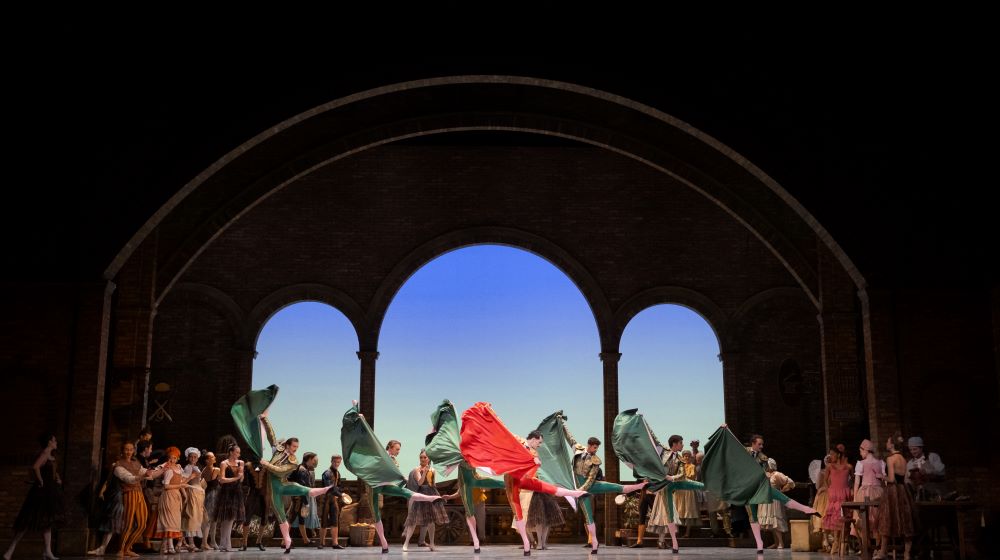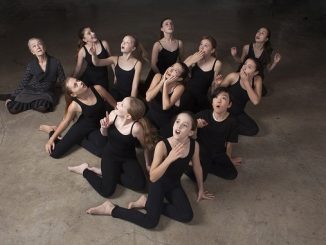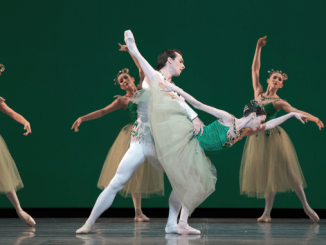The 1869 ballet version of Don Quixote, choreographed by Marius Petipa to a score by composer Ludwig Minkus, has probably gone through more reimaginings than the Man of La Mancha himself.
The National Ballet’s version, overseen by legendary dancer/choreographer Carlos Acosta, working alongside contemporary composer Hans Vercauteren, debuted in 2013 with the Royal Ballet (London), and is making its North American debut here at the Four Seasons Centre with this production.
While the ballet may lack the more memorable tunes found in the Tchaikovskys or Stravinskys of the form, it’s still a delight, with great music, fine comic stylings, and a couple of wonderful dance numbers, including the fabled pas de deux from the finale.

There’s some fine tilting at windmills in the National Ballet’s current production of Don Quixote, the set design combining lovely physical props with digital projections to capture the title character’s fantastical imagination. Indeed, the Act 2, Scene III attack on the windmills is one of the best parts of this remount.
Also fine are the dancers, who, on the evening your Toronto Guardian attended, included principal dancer Genevieve Penn Nabity as the maiden Kitri, fellow principal Harrison James as Basilio, her betrothed, and legendary sexagenarian Rex Harrington in the title role (who, a couple decades ago, wowed audience as Basilio here in Toronto in the same ballet).
The name Don Quixote for this ballet is honestly a bit misleading. While the character’s journey is used as a framing device, it’s really more of a pastoral love story centered on the young couple Kitri and Basilio. Quixote (Harrington) largely remains on the margins – or is wholly absent from – most scenes, while Kitri (Penn Nabity) and Basilio (James) are the real stars. That said, Sancho Panza (Jason Ferro) does his best to steal the show with his comic antics any time he’s on stage, his comedic counterpart being the foppish nobleman Gamache (Donald Thom), with his extravagant and ornate clothing, hair, and manner.
The score, adapted by Vercauteren from Minkus’s original composition, does a serviceable job of capturing the Spanish mood – there’s a lot of clapping and tambourines – though there are no real musical showstoppers. The set design really is rather lovely, with elegant scene transitions and at least one sequence – Quixote’s dream of a garden of dryads, all dangling vines and beautiful costumes – which comes closest to replicating the transcendent beauty of other, slightly more famous ballets.
From a dance perspective, the highlights are, as mentioned, the finale pas de deux – one of the highlights of the repertoire, in fact – as well as the two solo pieces, one for Kitri (Penn Nabity) and one for Basilio (James), which tee up the pas de deux. Throughout, there are plentiful opportunities for the National Ballet’s stellar ensemble to flex their muscles, from captivating Bohemian dances to formal ballroom affairs. There’s a reason why the National Ballet is regarded as one of the best ballet companies in the world, and shows like Don Quixote are proof of that.
Narratively, this Quixote doesn’t really capture the spirit of the satirical – and far funnier – source material, though it doesn’t have to. Resting on the tried-and-true formula of young love + dream sequence + at least one fancy dress ball, Quixote is more of a good-natured love story than anything else. That’s fine, and there’s more than enough here – the costumes/set design are just fantastic – to keep audiences engaged and entertained.
***
For tickets to the National Ballet’s Don Quixote, click here.



